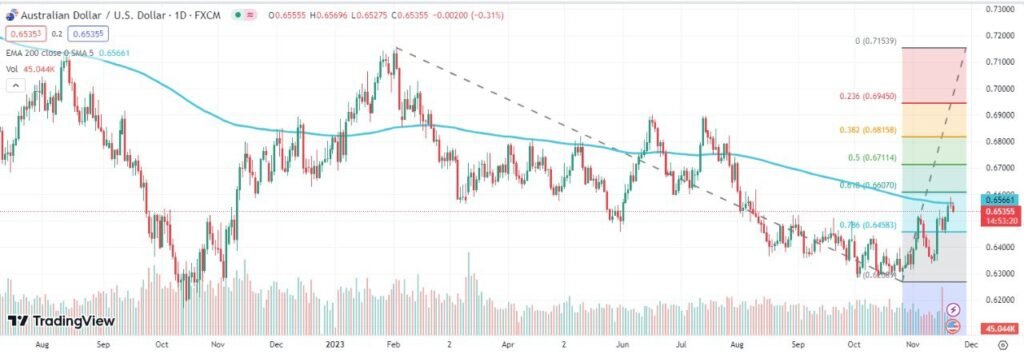Contents
- 1 Insights into Monetary Policy, Rate Hikes, and Economic Uncertainties
- 2 Market Watch: Potential Impact of US Economic Indicators on Federal Reserve Rate Decisions
- 3 AUD/USD Decline Analysis: Balancing Bullish Signals and Bearish Indicators in the Current Market Landscape
- 4 AUD/USD Decline: Technical Analysism, Key Indicators and Potential Scenarios
The AUD/USD decline of 0.01% On Tuesday. Following a 0.65% increase on Monday, the Australian dollar concluded the day at $0.65555. The currency reached a peak of $0.65895 before receding to a low of $0.65444.
Insights into Monetary Policy, Rate Hikes, and Economic Uncertainties
AUD/USD decline in the light that Wednesday brings the Reserve Bank of Australia (RBA) into focus following the release of the RBA meeting minutes. RBA Governor Michele Bullock is scheduled to address the ABE Annual Dinner, providing insights into the recent monetary policy decision. On November 7, the RBA implemented a 25 basis points increase, bringing the cash rate to 4.35%. Recent indicators of Australian wage growth and employment have generated expectations of additional rate hikes. However, apprehensions among Board members persist due to uncertainties surrounding the global and Chinese economies. That coupled with concerns about Australian household spending.
Comments on inflation, the economic outlook, and cash rates are poised to impact buyer demand for the Australian dollar. RBA Governor Michele Bullock, on Tuesday, hinted at the potential for further rate hikes to address wage growth. She commented on the underlying drivers of inflation, stating, “But actually, there’s an underlying demand component to it as well, and that’s what the central banks are trying to get on top of.”
An elevated cash rate would increase borrowing costs, subsequently diminishing disposable income. Downtrends in disposable income could impact consumer spending, thereby tempering demand-driven inflationary pressures.
Noteworthy on Wednesday is the absence of Australian economic data for investors to consider.
Market Watch: Potential Impact of US Economic Indicators on Federal Reserve Rate Decisions
Wednesday will draw investor attention to US jobless claims and Michigan Consumer Sentiment figures. Should there be a downward adjustment to the preliminary consumer sentiment and an unexpected uptick in jobless claims. It could reinforce expectations of a Federal Reserve rate cut in May.
Deteriorating conditions in the labor market and a dip in consumer sentiment have implications for consumer spending. A decline in consumer spending would alleviate inflationary pressures driven by demand. This easing of demand-induced inflationary pressures might afford the Federal Reserve the flexibility to implement rate cuts, with the aim of preventing a severe economic downturn.
Also Read: Bullock Speech Sends Strong Caution on Wages
Economists are predicting a decline in initial jobless claims from 231k to 225k for the week ending November 18. According to preliminary data, the Michigan Consumer Sentiment Index slipped from 63.8 to 60.5 in November.
AUD/USD Decline Analysis: Balancing Bullish Signals and Bearish Indicators in the Current Market Landscape
The AUD/USD Decline buthas consistently maintained a position above the 50-day Exponential Moving Average (EMA) while residing below the 200-day EMA, signaling a bullish outlook in the short term but conveying bearish indications over an extended period.
A breakthrough of the 200-day EMA for the AUD/USD would empower bullish momentum, opening the path for an attempt at the trend line and the resistance level at $0.66162.
Noteworthy elements to watch include speeches by RBA Governor Michele Bullock and US economic indicators.
However, a retracement beneath the $0.65 mark would suggest potential support, potentially leading to a descent towards the support level at $0.64900.

The 14-period Daily Relative Strength Index (RSI) reading of 63.26 implies a potential upward move towards the $0.66162 resistance level before entering the overbought territory, typically identified above 70 on the RSI scale.
AUD/USD Decline: Technical Analysism, Key Indicators and Potential Scenarios
The AUD/USD Decline but remains positioned above both the 50-day and 200-day Exponential Moving Averages (EMAs). Validating bullish signals in the short term.
An upward breach of the trend line in the AUD/USD would activate the $0.66162 resistance level.
On the flip side, a descent below the $0.65 mark would suggest a potential decline towards the 50-day EMA and the support level at $0.64900.

With a 14-period 4-Hourly Relative Strength Index (RSI) reading of 62.73, there are indications that the AUD/USD may revisit $0.66 before entering the overbought territory, typically identified above 70 on the RSI scale.








